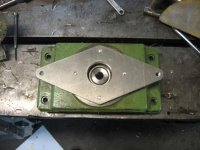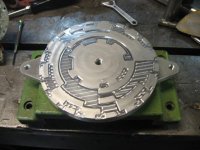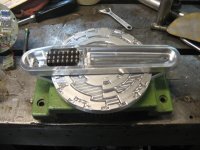1982 Mori-Seiki MV-45 20 pot toolchanger
It has a Yamatake-Honeywell Binary absolute encoder on the toolchanger magazine that has been giving me fits. The encoder uses a black painted plastic wheel with clear windows to trigger phototransistors. It has a 4" diameter board inside with many resistors, transistors, one small IC and a few capacitors. It has blown a few switching transistors on this board in the 2 years I have owned the machine. Replace bad transistor, good to go for a while.
It has now developed a problem proving very difficult to troubleshoot. When the machine is running for several hours a large current resistor inside the encoder, mounted on the board, gets quite hot, the heat somehow effects the encoder to hold one of the signal transistors on. Right now the transistor for Binary 1 is on so all even number tool pots give an error. The problem floats, so far it has been different Binary values stuck on when it occurs. Once it happens though, the incorrect bit stays the same until the machine cools off and I run it again another day.
At the moment I am running the machine. When the encoder acts up I have the cover off to blast it with shop air, cool it down and it goes back to working fine.
I use a great tech, but he hasn't been able to troubleshoot the problem when it's actually occurred. He's scoped out the encoder, run it on his bench and can't duplicate the problem.
At this point I'm gearing up for a large run of parts. But that said, I don't have the budget to buy this encoder new for $5K or send it off and have it "pro repaired with warranty" for $1500 plus down time.
At this point it seems like my options are-
Mount heat generating power resistor remotely outside encoder housing (temporary stop-gap).
Locate and order replacements for every component on the board and replace everything with modern equivalents.
Get rid of the old encoder entirely and retrofit something modern or go stupid basic and machine a big wheel with microswitches or prox sensors to replace the encoder.
What would you guys do for a retrofit encoder solution? This thing is 24 volt, Binary with parity check and a strobe 0 through 20 in Binary geared 1:1 with the tool magazine.
It has a Yamatake-Honeywell Binary absolute encoder on the toolchanger magazine that has been giving me fits. The encoder uses a black painted plastic wheel with clear windows to trigger phototransistors. It has a 4" diameter board inside with many resistors, transistors, one small IC and a few capacitors. It has blown a few switching transistors on this board in the 2 years I have owned the machine. Replace bad transistor, good to go for a while.
It has now developed a problem proving very difficult to troubleshoot. When the machine is running for several hours a large current resistor inside the encoder, mounted on the board, gets quite hot, the heat somehow effects the encoder to hold one of the signal transistors on. Right now the transistor for Binary 1 is on so all even number tool pots give an error. The problem floats, so far it has been different Binary values stuck on when it occurs. Once it happens though, the incorrect bit stays the same until the machine cools off and I run it again another day.
At the moment I am running the machine. When the encoder acts up I have the cover off to blast it with shop air, cool it down and it goes back to working fine.
I use a great tech, but he hasn't been able to troubleshoot the problem when it's actually occurred. He's scoped out the encoder, run it on his bench and can't duplicate the problem.
At this point I'm gearing up for a large run of parts. But that said, I don't have the budget to buy this encoder new for $5K or send it off and have it "pro repaired with warranty" for $1500 plus down time.
At this point it seems like my options are-
Mount heat generating power resistor remotely outside encoder housing (temporary stop-gap).
Locate and order replacements for every component on the board and replace everything with modern equivalents.
Get rid of the old encoder entirely and retrofit something modern or go stupid basic and machine a big wheel with microswitches or prox sensors to replace the encoder.
What would you guys do for a retrofit encoder solution? This thing is 24 volt, Binary with parity check and a strobe 0 through 20 in Binary geared 1:1 with the tool magazine.





